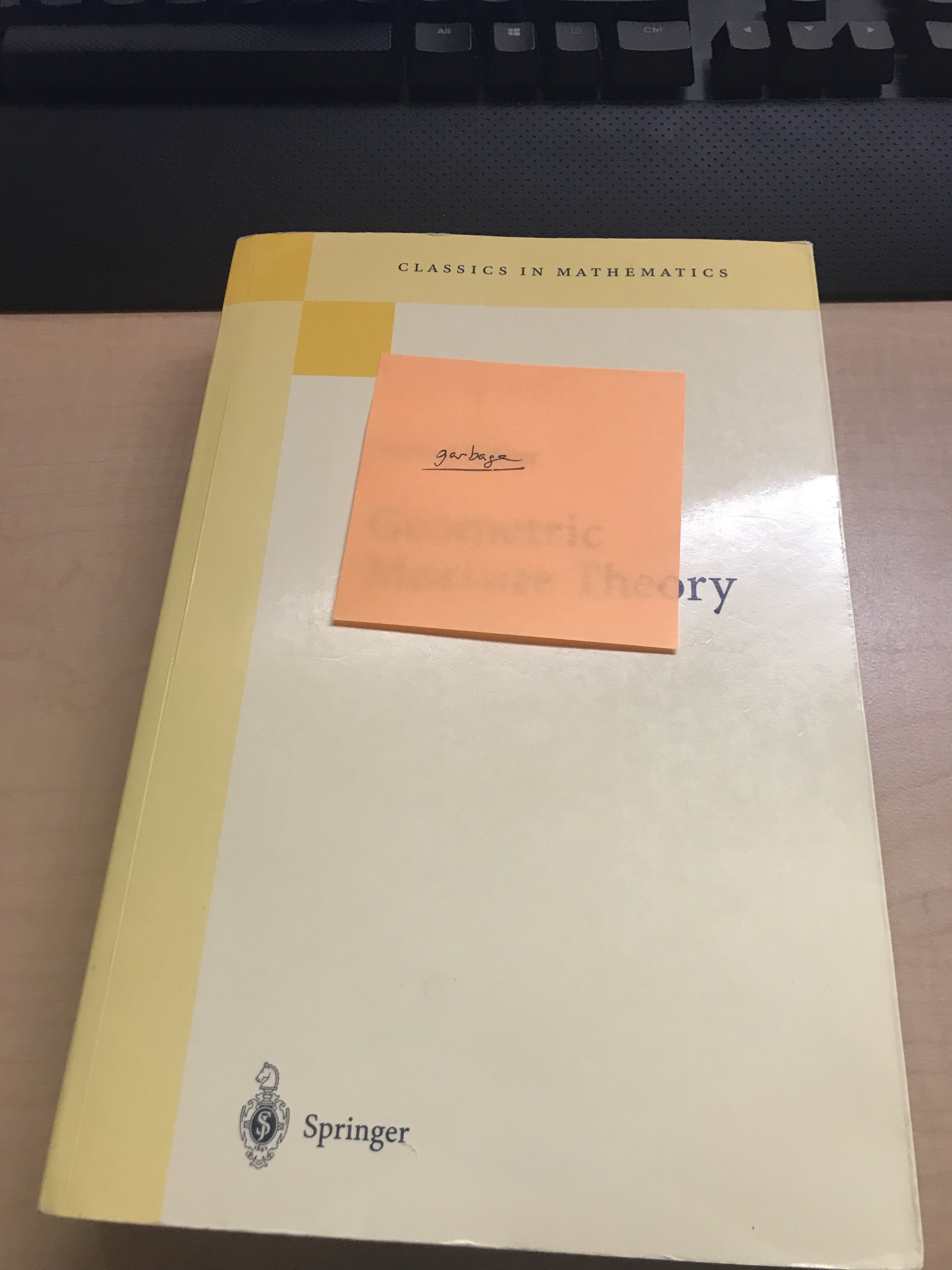9:11 AM
where $\int^{\int^{\int}} = e^{e^{\int \ln \int}\ln \int}$
Using the taylor series for ln and exp, we have:
\begin{align}e^{\int \ln \int} & = \sum_{n=0}^{\infty} \frac{(\int \sum_{m=1}^{\infty}(-1)^{m+1}\frac{(\int - 1)^m}{m})^n}{n!}\\ & = \sum_{n=0}^{\infty} \frac{(\int \sum_{m=1}^{\infty}(-1)^{m+1}\frac{\sum_{p=0}^m\binom{m}{p}(-1)^{m-p}\int^{(m)}}{m})^n}{n!}\\ & = \sum_{n=0}^{\infty} \left(\int \sum_{m=1}^{\infty}\int^{(m)}\sum_{p=0}^m\frac{(-1)^{2m+1-p}\binom{m}{p}}{(n!)^{\frac{1}{n}}m}\right)^n\\ \end{align}
\begin{align}
e^{e^{\int \ln \int}\ln \int} & = \sum_{s=0}^{\infty}\frac{\left(\sum_{n=0}^{\infty} \left(\int \sum_{m=1}^{\infty}\int^{(m)}\sum_{p=0}^m\frac{(-1)^{2m+1-p}\binom{m}{p}}{(n!)^{\frac{1}{n}}m}\right)^n\sum_{q=1}^{\infty}\int^{(q)}\sum_{r=0}^q\frac{(-1)^{2q+1-r}\binom{q}{r}}{q}\right)^s}{s!}\\
& = \sum_{s=0}^{\infty}\left(\sum_{q=1}^{\infty}\sum_{n=0}^{\infty} \left(\int \sum_{m=1}^{\infty}\int^{(m)}\sum_{p=0}^m\frac{(-1)^{2m+1-p}\binom{m}{p}}{(n!)^{\frac{1}{n}}m}\right)^n\int^{(q)}\sum_{r=0}^q\frac{(-1)^{2q+1-r}\binom{q}{r}}{(s!)^{\frac{1}{s}}q}\right)^s
Note the innermost summation of each term can be simplified (writing...)
$$\sum_{r=0}^q \frac{(-1)^{2q+1-r}\binom{q}{r}}{(s!)^{\frac{1}{s}}q} = \frac{1}{(s!)^{\frac{1}{s}}q}\sum_{r=0}^q (-1)^{1-r}\binom{q}{r}$$
For the latter sum, observed that if q is odd, then the sum vanishes because of the symmetry $\binom{q}{r}=\binom{q}{q-r}$
Likewise, if q is even, then we have $\binom{q}{\lfloor \frac{q}{2}\rfloor}+2\sum_{r=0}^{\lfloor \frac{q}{2}\rfloor-1}\binom{q}{r}$
$\binom{q}{\lfloor \frac{q}{2}\rfloor}+2\sum_{r=0}^{\lfloor \frac{q}{2}\rfloor-1}(-1)^r\binom{q}{r}$
$$\sum_{r=0}^{\lfloor \frac{q}{2}\rfloor-1}(-1)^r\binom{q}{r} = (-1)^{\lfloor\frac{q}{2}\rfloor-1}\binom{q-1}{\lfloor\frac{q}{2}\rfloor-1}$$
actually sorry, there's a simpler way:
Again we consider the sum 4 lines above
We then make the observation that $(-1)^{-a}=(-1)^{a}$ for any integer $a$ to rewrite it as:
$$\sum_{r=0}^q \frac{(-1)^{2q+1-r}\binom{q}{r}}{(s!)^{\frac{1}{s}}q} = \frac{1}{(s!)^{\frac{1}{s}}q}\sum_{r=0}^q (-1)^{1-r}\binom{q}{r} = \frac{1}{(s!)^{\frac{1}{s}}q}\sum_{r=0}^q (-1)^{r-1}\binom{q}{r} = -\frac{1}{(s!)^{\frac{1}{s}}q}\sum_{r=0}^q (-1)^{r}\binom{q}{r}$$
no by the result in ProofWiki, we found the sum is equal to $\delta_{q0}$
and hence the integral simplifies to:
\begin{align}
e^{e^{\int \ln \int}\ln \int}& = \sum_{s=0}^{\infty}\left(\sum_{q=1}^{\infty}\sum_{n=0}^{\infty} \left(\int \sum_{m=1}^{\infty}\int^{(m)}\sum_{p=0}^m\frac{(-1)^{2m+1-p}\binom{m}{p}}{(n!)^{\frac{1}{n}}m}\right)^n\int^{(q)}\sum_{r=0}^q\frac{(-1)^{2q+1-r}\binom{q}{r}}{(s!)^{\frac{1}{s}}q}\right)^s\\ & = \sum_{s=0}^{\infty}\left(\sum_{q=1}^{\infty}\sum_{n=0}^{\infty} \left(\int \sum_{m=1}^{\infty}\int^{(m)}\left(-\frac{\delta_{m0}}{(n!)^{\frac{1}{n}}m}\right)\right)^n\int^{(q)}\left(-\frac{\delta_{q0}}{(s!)^{\frac{1}{s}}q}\right)\right)^s
Now because both m and q are never zero, it means all the terms with dirac deltas vanishes, can be bubbled out from the integrals (since they have no dependence on x) and thus we have:
\begin{align}
e^{e^{\int \ln \int}\ln \int}& = \sum_{s=0}^{\infty}\left(\frac{1}{(s!)^{\frac{1}{s}}}\sum_{q=1}^{\infty}\left(\frac{\delta_{q0}}{q}\right)\sum_{n=0}^{\infty} C^n\int^{(q)}\right)^s\\
& = \sum_{s=0}^{\infty}\left(\frac{1}{(s!)^{\frac{1}{s}}}\sum_{q=1}^{\infty}\left(\frac{\delta_{q0}}{q}\right)\sum_{n=0}^{\infty} C^n\int^{(q)}\right)^s
\end{align}
\begin{align}
e^{e^{\int \ln \int}\ln \int}& = \sum_{s=0}^{\infty}\left(\frac{1}{(s!)^{\frac{1}{s}}}\sum_{q=1}^{\infty}\left(\frac{\delta_{q0}}{q}\right)\sum_{n=0}^{\infty} C^n\int^{(q)}\right)^s\\
& = \sum_{s=0}^{\infty}\left(\frac{1}{(s!)^{\frac{1}{s}}}\sum_{q=1}^{\infty}\left(\frac{\delta_{q0}}{q}\right)\sum_{n=0}^{\infty} \frac{C^n}{n!}\int^{(q)}\right)^s\\
& = \sum_{s=0}^{\infty}\left(\frac{1}{(s!)^{\frac{1}{s}}}0\right)^s\\
& = 0
\end{align}
and therefore, for any integrable function $f$
$$\int^{\int^{\int}}f(x) dx = 0$$
$$\int^{\int} f(x) dx = \sum_{n=0}^{\infty}\frac{C^n}{n!}=e^C-1$$
The more interesting question for future work for any interested readers is whether there exists other integral forms that has such "singular" behaviour in the space of all integrable functions. i.e.:
$$g\left(\int\right) f(x) dx = h(x)$$
where $g$ is some relation, $f$ is any integrable function and $h$ is some fixed function







